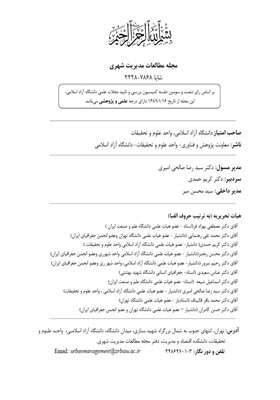نقش مدیریت زمینه گرا در شکل گیری منظر تاریخی تخت سلیمان
محورهای موضوعی : مطالعات مدیریت شهریسیدمنصور رشیدی 1 , سحر طوفان 2 * , احد نژاد ابراهیمی 3
1 - دانشجوی دکتری تخصصی معماری، دانشکده هنر و معماری، واحد تبریز، دانشگاه آزاد اسلامی، تبریز، ایران. stu.rashidi@iaut.ac.ir
2 - دانشیار، گروه معماری، دانشکده هنر و معماری، واحد تبریز، دانشگاه آزاد اسلامی، تبریز، ایران. sahar.toofan@iaut.ac.ir (نویسنده مسئول)
3 - استاد، دانشکده مهندسی معماری و شهرسازی، دانشگاه هنرهای اسلامی تبریز، تبریز، ایران. ahadebrahimi@tabrizian.ac.ir
کلید واژه:
چکیده مقاله :
مقدمه و هدف پژوهش: منظر شهری تاریخی به عنوان گونه ای از منظرهای فرهنگی، رویکردی جدید نسبت به شهر را مطرح می کند که در آن بازخوانی تعامل پایدار انسان و طبیعت در بستر شهر تاریخی مورد توجه است. شهرستان تکاب بهعنوان یکی از شهرهای استان آذربایجان غربی علیرغم داشتن انواع جادههای دیدنی مانند جاذبههای تاریخی، ازجمله مجموعه باستانی تخت سلیمان که بهعنوان چهارمین اثر تاریخی کشور در فهرست میراث جهانی یونسکو ثبتشده و جادههای طبیعی همچون دریاچه تخت سلیمان، کوه زندان، چین متحرک چملی و دارا بودن تعدادی چشمه آب گرم و سرد معدنی، درزمینه زیستی و گردشگری دارای وضعیت کاملاً مناسب نمیباشد. روش پژوهش: این پژوهش بر مبنای روش کلی توصیفی- تحلیلی انجام شده است. روش تجزیه و تحلیل دادهها با استفاده از نرمافزاری تحلیلی مانند spss و روش آمار توصیفی چولگی و کشیدگی و نمودار هیستوگرام بررسی مولفه های و متغیرها با استفاده از تحلیل های آماری و همبستگی و آزمون های شاخص دریافتی به تجزیه و تحلیل دادههای بهدستآمده پرداخته و از جدولSWOT نیز بهمنظور تجزیه و تحلیل نهایی اطلاعات و دادهها نقاط قوت و ضعف مجموعه به کار گرفته شده است. یافتهها: مقدار عددی ضریب آلفای کرونباخ که شامل 25 سوال پرسش نامه را در نظر گرفته است برابر با 0.947 به دست آمده که نشان می دهد پرسشنامه دارای پایایی مورد قبول و عالی می باشد. نتیجه گیری: دستیابی به طراحی زمینه گرا و هماهنگی با بستر ناممکن نیست و حتی با الگوی از محل و استفاده از مصالح بومی، می توان عوامل محیطی را در طرح ها در نظر گرفت. ارزش های تاریخی و رابطه آنها با شیوه های مدیریت در مواجهه با چگونگی مرمت و میراث معماری و به خصوص در دوره های تاریخی، عناصر کالبدی، فضایی و مواد و مصالح آن با توجه به زمینه گرایی در نظر گرفت.
Abstract Introduction and Purpose: historical urban landscape as a type of cultural landscape suggests a new approach to the city in which the sustainable interaction of man and nature in the context of the historical city is of interest. Takab city as one of the cities of West Azarbaijan province, despite having a variety of scenic roads such as historical attractions, including the Takht Suleiman ancient complex, which is registered as the fourth historical monument of the country in the UNESCO World Heritage List, and natural roads such as Takht Suleiman Lake, Prison Mountain, Chamli Moving China and Having a number of hot and cold mineral water springs is not quite suitable in the field of biology and tourism. Method: This research was conducted based on the overall descriptive-analytical method. The method of data analysis using analytical software such as spss and the method of descriptive statistics of skewness and kurtosis and histogram chart to examine the components and variables using statistical analysis and correlation and index tests to analyze the obtained data. And the SWOT table has been used for the final analysis of information and data, the strengths and weaknesses of the collection. Findings: The numerical value of Cronbach's alpha coefficient, which includes 25 questions of the questionnaire, is equal to 0.947, which shows that the questionnaire has acceptable and excellent reliability. Conclusion: It is not impossible to achieve context-oriented design and coordination with the substrate, and even with the local model and the use of local materials, environmental factors can be considered in the designs. Historical values and their relationship with management methods in the face of restoration and architectural heritage, especially in historical periods, physical and spatial elements and its materials and materials were considered with regard to contextualism.

